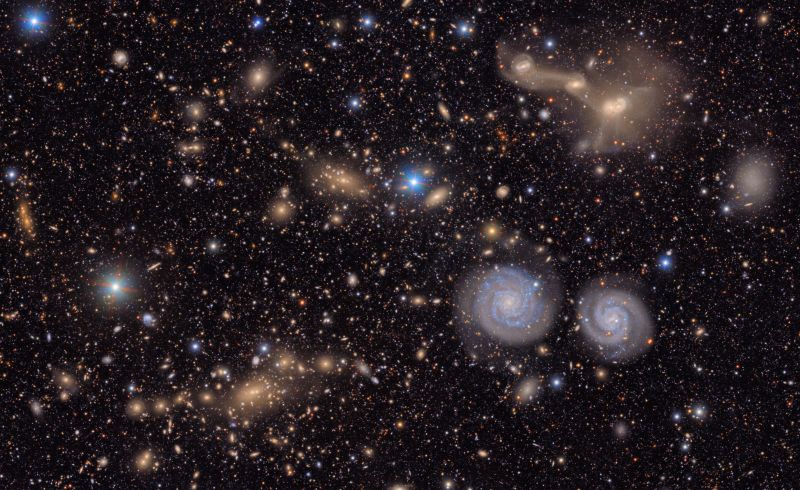
Ever-changing universe revealed in first imagery from NSF-DOE Vera C. Rubin Observatory
How did your country report this? Share your view in the comments.
Diverging Reports Breakdown
Ever-changing universe revealed in first imagery from NSF-DOE Vera C. Rubin Observatory
NSF-DOE Vera C. Rubin Observatory released its first imagery today at an event in Washington, D.C. In just over 10 hours of test observations, the facility has already captured millions of galaxies and Milky Way stars and thousands of asteroids. The imagery is a small preview of Rubin Observatory’s upcoming 10-year scientific mission to explore and understand some of the universe’s biggest mysteries. Later in 2025, Rubin will begin its primary mission, the Legacy Survey of Space and Time, in which it will ceaselessly scan the sky nightly for 10 years to precisely capture every visible change. The images will reveal asteroids and comets, pulsating stars, supernova explosions, far-off galaxies and perhaps cosmic phenomena that no one has seen before. Rubin will be a game changer for planetary defense by spotting asteroids, comets and interstellar objects, potentially identifying some that might impact the Earth or moon before they are seen by humans. The facility will also be the most efficient and effective solar system machine ever built.
“The NSF-DOE Vera C. Rubin Observatory demonstrates that the United States remains at the forefront of international basic science and highlights the remarkable achievements we get when the many parts of the national research enterprise work together,” said Michael Kratsios, director of the White House Office of Science and Technology Policy. “The Rubin Observatory is an investment in our future, which will lay down a cornerstone of knowledge today on which our children will proudly build tomorrow.”
“NSF-DOE Rubin Observatory will capture more information about our universe than all optical telescopes throughout history combined,” said Brian Stone, performing the duties of the NSF director. “Through this remarkable scientific facility, we will explore many cosmic mysteries, including the dark matter and dark energy that permeate the universe.”
“We’re entering a golden age of American science,” said Harriet Kung, acting director of DOE’s Office of Science. “NSF-DOE Rubin Observatory reflects what’s possible when the federal government backs world-class engineers and scientists with the tools to lead. This facility will drive discovery, inspire future innovators and unleash American excellence through scientific leadership.”
Made from over 1,100 images captured by NSF-DOE Vera C. Rubin Observatory, the video begins with a close-up of two galaxies then zooms out to reveal about 10 million galaxies. Those 10 million galaxies are roughly .05% of the approximately 20 billion galaxies Rubin Observatory will capture during its 10-year Legacy Survey of Space and Time. Credit : NSF-DOE Vera C. Rubin Observatory
The result of more than two decades of work, Rubin Observatory is perched at the summit of Cerro Pachón in Chile, where dry air and dark skies provide one of the world’s best observing locations. Rubin’s innovative 8.4-meter telescope has the largest digital camera ever built, which feeds a powerful data processing system. Later in 2025, Rubin will begin its primary mission, the Legacy Survey of Space and Time, in which it will ceaselessly scan the sky nightly for 10 years to precisely capture every visible change.
The result will be an ultrawide, ultra-high-definition time-lapse record of the universe. It will bring the sky to life with a treasure trove of billions of scientific discoveries. The images will reveal asteroids and comets, pulsating stars, supernova explosions, far-off galaxies and perhaps cosmic phenomena that no one has seen before.
In about 10 hours of observations, NSF-DOE Vera C. Rubin Observatory discovered 2,104 never-before-seen asteroids in our solar system, including seven near-Earth asteroids (which pose no danger). Annually, about 20,000 asteroids are discovered in total by all other ground and space-based observatories. Rubin Observatory alone will discover millions of new asteroids within the first two years of the Legacy Survey of Space and Time. Rubin will also be the most effective observatory at spotting interstellar objects passing through the solar system. Credit : NSF-DOE Vera C. Rubin Observatory
Rubin Observatory is named in honor of trailblazing U.S. astronomer Vera C. Rubin, who found conclusive evidence of vast quantities of invisible material known as dark matter. Understanding the nature of dark matter, dark energy and other large-scale cosmic mysteries is a central focus of Rubin Observatory’s mission. Dark energy is what scientists call the mysterious and colossally powerful force that appears to be causing galaxies in the universe to move away from each other at an accelerating rate. Although dark matter and dark energy collectively comprise 95% of the universe, their properties remain unknown.
Rubin Observatory will also be the most efficient and effective solar system discovery machine ever built. Rubin will take about a thousand images of the Southern Hemisphere sky every night, allowing it to cover the entire visible Southern sky every three to four nights. In doing so, it will find millions of unseen asteroids, comets and interstellar objects. Rubin will be a game changer for planetary defense by spotting far more asteroids than ever before, potentially identifying some that might impact the Earth or moon.
Credit: NSF-DOE Vera C. Rubin Observatory This image combines 678 separate images taken by NSF-DOE Vera C. Rubin Observatory in just over seven hours of observing time. Combining many images in this way clearly reveals otherwise faint or invisible details, such as the clouds of gas and dust that comprise the Trifid nebula (top right) and the Lagoon nebula, which are several thousand light-years away from Earth.
Explore this image in full resolution on the NSF-DOE Rubin Observatory website.
The amount of data gathered by Rubin Observatory in its first year alone will be greater than that collected by all other optical observatories combined. This treasure trove of data will help scientists make countless discoveries about the universe and will serve as an incomparable resource for scientific exploration for decades to come.
Source: https://www.nsf.gov/news/first-imagery-nsf-doe-vera-c-rubin-observatory
